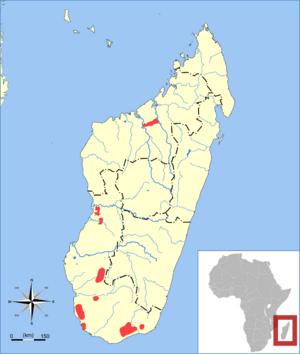Large-eared tenrec facts for kids
Quick facts for kids Large-eared tenrec |
|
|---|---|
| Conservation status | |
| Scientific classification | |
 |
|
| Large-eared tenrec range |
The large-eared tenrec (Geogale aurita) is a small, unique mammal that lives only on the island of Madagascar. It's part of the family Tenrecidae, which are small, insect-eating animals found mostly in Madagascar. This tenrec is the only species in its group, called Geogale, and the only member of the subfamily Geogalinae. It lives in dry forests and bushy areas. Even though its home is shrinking, experts believe it's not in great danger right now. Because of this, it is listed as "Least Concern" by the IUCN.
Scientists think the Geogale group separated from its closest relatives, the Oryzorictinae subfamily, about 30 million years ago.
What Does It Look Like?
The large-eared tenrec is a tiny animal, a bit like a shrew. It has short, soft fur, a long, furry tail, and big ears that stick out. Adult tenrecs weigh between 5 and 8 grams. They are about 60 to 75 millimeters (2.4 to 3 inches) long, with a tail that is about half their body length.
Their upper body (back) is greyish-brown or reddish-brown. Their underside (belly) is a light, buffish-white color. The large-eared tenrec is different from other tenrecs because it has 34 teeth instead of 36. It's also special because female tenrecs can get pregnant again while they are still feeding their babies. This means they can be carrying one litter of babies while still nursing another!
Behaviour and Life Cycle
The large-eared tenrec eats insects, especially termites. It finds these insects by listening carefully for them. Other animals hunt the large-eared tenrec. These predators include the barn owl (Tyto alba), the Madagascar owl (Asio madagascariensis), the Malagasy cat-eye snake (Madagascarophis colubrinus), and the narrow-striped mongoose (Mungotictis decemlineata).
This tenrec has a low metabolic rate. This means its body temperature can change with the temperature of its surroundings. This is called heterothermy. However, pregnant and nursing females might keep their body temperature more steady and higher. These animals often become torpid (a state of reduced activity) during the hottest parts of the day. They hide in safe places like hollow logs or holes.
Not much is known about how they reproduce. The breeding season is usually between September and March. Sometimes, the development of the babies can pause for a while. This means the gestation period (how long the mother carries the babies) can vary from about 54 to 69 days. A mother tenrec can have up to five babies in a litter. These young are born blind, deaf, and helpless. They are fed by their mother until they are between 21 and 33 days old, which is soon after their eyes open.
How It Is Doing
The IUCN lists the large-eared tenrec as being of "Least Concern" on its Red List of Threatened Species. This means it's not currently facing a high risk of becoming extinct. We don't know if their numbers are going up or down.
Even though this tenrec has been found in different scattered areas of Madagascar, it's a small animal that's hard to spot. So, it's probably living in many more places than we currently know. People used to think it only lived in dry forests. But now, it has also been found in grasslands. This suggests it can handle changes to its home better than scientists first thought. Some of the places where it lives are protected in national parks and nature reserves.
See also
- Convergent evolution
- List of mammals of Madagascar


